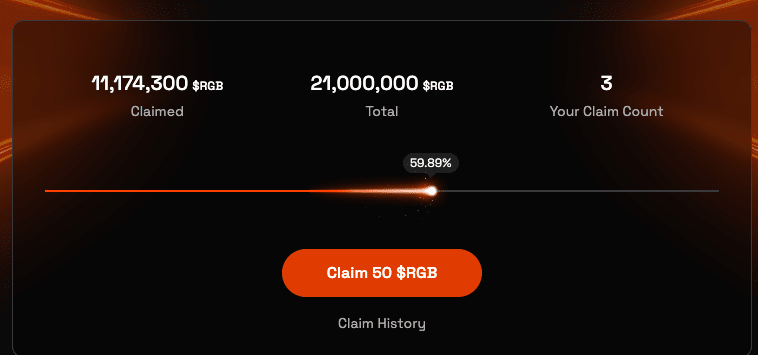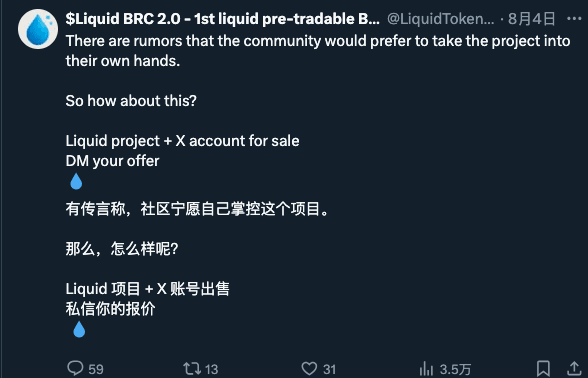Original author: golem
Reprint: Daisy, Mars Finance.
Recently, the overall activity level of the Bitcoin ecosystem has risen, and many long-developed projects have entered the delivery or new milestone stage, such as RGB, sat 20, BRC 2.0, etc. Odaily Planet Daily will briefly summarize the progress of related projects in this article for ecosystem players to explore wealth codes.
RGB Protocol: The first token on the mainnet will reopen claims on August 14.
The RGB protocol launched on the Bitcoin mainnet on August 7, simultaneously issuing the first token on the mainnet, RGB, with a total supply of 21 million, adopting a fair claiming model, but each claim requires a fee of about $4.
According to community estimates, it will take about 24 hours to complete the RGB token claims, however, the actual situation is that as of now (5 days in total), the RGB token claiming progress is at 60%. The main reason may be that the event was too popular, causing excessive website traffic and long claiming queues. Bitlight Labs has repeatedly upgraded servers, paused claims to upgrade defense measures against bots, and other actions.

According to the official announcement, Bitlight Labs has basically completed defense measures against bot claims and plans to release Bitlight wallet version 1.1.3 at 17:00 on August 14, 2025, reopening RGB token claims, but this time only 10% of the tokens will be open for claiming tests. If the test results are satisfactory, the remaining RGB token claims will gradually reopen.
Although the RGB protocol's mainnet launch did not meet user expectations and even faced significant FUD, from the claiming process, Bitlight Labs is still continuously developing improvements and actively combating bot claiming activities, thereby maintaining a certain degree of fairness in claims and token distribution, preventing a concentration of tokens in the hands of a few, which is beneficial for future community development.
Even though there is currently no official trading market, the RGB tokens that have been distributed can be directly transferred through wallets, with the current price of a single RGB (50 tokens) being $10-13, achieving a return of 2-3 times compared to the claiming cost. Therefore, after the claiming reopens on August 14, the competition for claims may intensify further. For more information about the RGB protocol and claiming tutorials, you can read Odaily's previous articles. (Related Reading: After waiting two years, is this the RGB protocol's mainnet launch?)
BRC 2.0 upgrade: The first phase has been postponed to September 2.
BRC 2.0 is an upgrade to the BRC 20 protocol launched by Best in Slot, aimed at enabling EVM-compatible smart contract functionality for all BRC 20 tokens. Best in Slot originally planned to conduct the first phase of the BRC 2.0 upgrade at block height 909969 (around August 14) on the mainnet, enabling 6-character BRC 20 tokens and launching a launchpad, but due to insufficient preparation, the upgrade has been postponed to block height 912,690, approximately on September 2.
Perhaps due to the postponement of the upgrade date, the overall market value of Pre-BRC 2.0 assets has also declined. The first BRC 2.0 concept NFT Adderrels currently has a floor price of 0.0076 BTC (approximately $900), down 60% from its peak. However, the Adderrels project team is still operating, updating details on staking NFTs to receive token airdrops, which will be distributed in three seasons, releasing a total supply of 8%, 9%, and 10% respectively, with the first quarter token airdrop distributed when BRC 2.0 goes live on September 2.
Another project claiming to be the first Pre-BRC 2.0 token minted on Ordinals, LIQUID, has moved towards a community CTO. Previously, the original project team of LIQUID intended to sell the entire project, causing a wave of panic. Currently, LIQUID's price is 0.00006 BTC, close to the minting cost.

For more information on the BRC 2.0 upgrade, you can read Odaily's previous articles. (Related Reading: Countdown to Mainnet, BRC 2.0 Upgrade Ignites BTC Ecosystem, Leading NFTs Increase Hundredfold in a Month | BTC Ecosystem)
SAT 20 Protocol: SatoshiNet Mainnet Launch.
The SAT 20 protocol is a BTC native asset issuance and circulation protocol that has been in development for two years. Its core feature is asset binding to satoshis, allowing them to flow freely. SatoshiNet (Satoshi Network) is a Bitcoin native Layer 2 built on the SAT 20 protocol, based on Lightning Channels + parallel BTC networks, aimed at expanding the liquidity of BTC mainnet native assets and supporting various protocol assets such as Ordinals, Runes, OrdX, BRC 20, etc. The SatoshiNet mainnet officially launched on August 8, 2025.
The core of SatoshiNet lies in four contract capabilities: asset launch contract (LaunchPool), asset transcendence contract (Transcend), AMM trading contract (Swap), and limit order trading contract (LimitOrder). These capabilities enable instant settlement, extremely low fees, and compatibility with Bitcoin assets.
Currently, SatoshiNet has deployed four transcendence contracts, namely BTC, pearl, and rarepizza (ordx assets), DOG•GO•TO•THE•MOON (Runes assets). ordx is the native asset issuance of the SAT 20 protocol, which is a reinforced version of the Ordinals protocol, and the issued assets are referred to as sat assets (SAT 20 ASSETS), with assets bound to satoshis, possessing their properties. Pearl is the first token of the ORDX protocol and has become the governance token of the SatoshiNet network.
The publicly disclosed team members of the SAT 20 protocol include market operations and English region business development huige and technical director Jian Gang Shan. SATSWAP is currently the first DEX of SatoshiNet, featuring token launches, trading markets, limit orders, and more.
Despite the SAT 20 protocol's two-year commitment to development and the formation of a solid community, it has not generated a wealth effect strong enough to attract more attention.
Bitcoin native Layer 2 Spark: Launchpad Launch.
Spark claims to be a Bitcoin native L2 designed for payments and settlements, but it does not support smart contracts and has its own token issuance standard LRC 20. On August 11, one of the two node operators of the Spark protocol, Spark Browser sparkscan, conducted LRC 20 AMM functionality tests on Flashnet, but the tests did not go smoothly, and it is estimated that it will take some time before the formal DEX launch.
Meanwhile, on August 1, the Bitcoin ecosystem token launch platform Luminex announced a collaboration with Spark officials to launch a Launchpad, which briefly excited ecosystem players, but it has not yet launched. However, on August 11, another LRC 20 Launchpad utxo.fun was launched simultaneously with Flashnet's AMM test, but it encountered serious issues, leading the platform to process user refunds and temporarily prohibit token issuance.
Despite this, the leading token of LRC 20, FSPKS (ending in b 55 e), still has a single floor price of $100, compared to the initial minting cost of $2, yielding 50 times the return. For more information about the Spark protocol, you can read Odaily's previous articles (Related Reading: Detailed Explanation of Spark and Ecosystem: a16z Support, PayPal Co-Founded New Bitcoin L2).
BitVM 2 Bitcoin Bridge Fiamma: Mainnet Launch.
Fiamma is a Bitcoin wealth management platform, with its core product being the non-custodial super application Fiamma One that allows users to earn BTC yields with one click, and Fiamma Bridge built on BitVM 2. On August 6, Fiamma officially launched, enabling the transfer of BTC to 11 chains including Ethereum, Arbitrum, Aptos, BNB Chain, Base, etc.
At the same time, to encourage user participation, Fiamma launched a points task on August 8, where Minting 0.00001 FIABTC can earn 1 alpaca point, holding 0.00001 FIABTC can earn 3 alpaca points per month, and depositing FIABTC into DeFi protocols can earn 12 alpaca points per month. FIABTC is 1:1 natively anchored to BTC, employing BitVM 2 technology to achieve minimal trust, while combining Fiamma Bridge and Fiamma One, Fiamma is expected to bring more on-chain earnings while protecting the funds of BTC holders.


